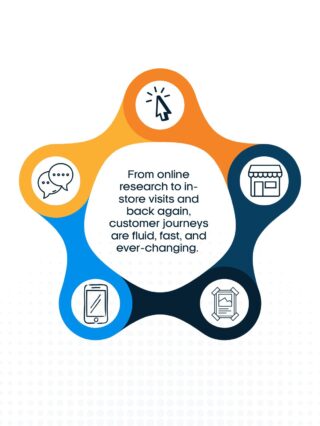The Rollout
App Tracking Transparency, also referred to as ATT, is an update Apple made to its privacy and data collection policy that launched in April 2021. This update requires all users to authorize or opt-in, to app-tracking. Yes, that’s right, with ATT, all iOS applications now have to ask permission to track the user’s data across other companies’ apps and websites, and the user has the choice to either “allow” or “ask app not to track.”
Let’s Talk Numbers
If you are an iOS user, you were likely affected by this update. According to AppsFlyer, 89% of US iOS users updated to version 14.5 or later as of December 2021. When delivered the new ATT privacy prompt, only 37% of users opted in. Considering Apple makes up a little more than half the US smartphone market, this is a substantial decrease in trackable users.
Although the opt-in metrics proved to be low, the percentage was slightly higher than initially anticipated. This indicates that some users may not be entirely against sharing their data as long as they are presented the information in an honest and ethical manner. Thus, app developers have the liberty to customize a brief message for the user explaining what their data will be used for if they decide to opt-in.
The Impact on Data Collection
When looking at the numbers above, it seems quite obvious that ATT has noticeably disrupted the available data collection for marketers. Before, users’ activity was being tracked across multiple websites and apps, allowing advertisers to formulate paths based on a user’s browsing history and interest categories. This gave advertisers the ability to develop highly-targeted data segments and provided them the ability to serve ads to users with a higher likelihood of clicking or converting.
This string of data was not only used for targeted advertising purposes, but it was also tremendously important for measuring ad campaign performance. With ATT in place, it is increasingly more challenging to connect those data points and interest levels from iOS users. As a result, less data on iOS users is available and conversion attribution and campaign measurement is more difficult than ever.
The Impact on Inventory Opportunities
To date, the impact on available inventory and bid opportunities has been subtle. While Butler/Till’s programmatic campaigns feature heavy mobile delivery, the iOS in-app traffic is not normally a major component for our clients. YTD we have delivered less than 5% of inventory in the iOS in-app channel. When taking a further look at the stats, the effective cost per thousand impressions (eCPMs) decreased slightly from early 2021 to now for both iOS and Android. Therefore, we believe the impact of iOS 14.5 has been minimal in the programmatic ecosystem.
Our Point of View
At Butler/Till, we are constantly mindful of consumer privacy and adapting to the ever-changing privacy regulations. First-party data has always been a steadfast option for us and is increasingly becoming more important as major mobile players, such as Apple, impose stricter privacy policies. The ATT privacy policy demonstrates just how crucial it is to either have your own first-party data available or have relationships with first-party data providers. With partnerships as one of the main focuses of our business, the agency has grown, cultivated, and secured relationships with some of the major data powerhouses in the industry.
Not only do we see an increase in the importance of first-party data, but we also see new opportunities to capture shifting ad dollars. Capitalizing on different segment formats, like contextual, demographics, or psychographic targeting can provide reliable targeting alternatives for advertisers.
Despite the recent ATT updates, the mobile ad industry will continue to dominate in the digital ad realm as mobile ad spend is expected to have steady growth. In fact, mobile ad spend is estimated by eMarketer to account for over two-thirds of all US digital ad spend this year. Rather than moving ad dollars away from the mobile market, advertisers are finding new ways to allocate their budgets accordingly. Whether that be to different operating systems or different formats of targeting, mobile advertising is here to stay—and here at BT, we couldn’t be more excited (and ready) for it.





